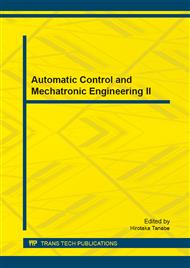p.180
p.184
p.188
p.192
p.196
p.200
p.209
p.216
p.220
Model Predictive Controller for the Flight Control of Ornithopters
Abstract:
The versatile and smart feature of MPC is the ease that it can work with MIMO plants, whereas adaptive PID controller is very difficult to implement and also provides unsatisfactory results unless updated to a rather complex controller by incorporating intelligent algorithms such as Particle Swarm Optimization, Genetic Algorithm and Neural Network. In this paper we present a novel but simple Model Predicative Controller for the Flight Control of Ornithopters. The performance was evaluated for the MISO and MIMO setup for almost all possible cases of various operating conditions resulting not only in faster response but also eliminating overshoot. The results obtained from the use of Model Predictive Controller for the flight control of the Micro Arial Vehicles shows comprehensively that MPC can be used as the future means for the control of these sophisticated and very complex ornithopters.
Info:
Periodical:
Pages:
196-199
Citation:
Online since:
September 2013
Price:
Сopyright:
© 2013 Trans Tech Publications Ltd. All Rights Reserved
Share:
Citation:


